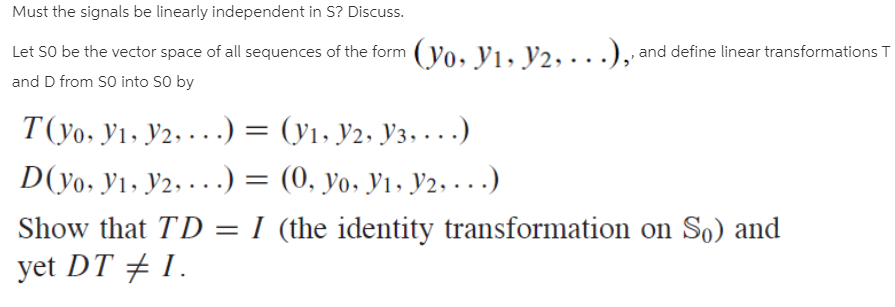Must the signals be linearly independent in S? Discuss. Let SO be the vector space of all sequences of the form (yo, yı, Y2, ·..), and D from SO into SO by and define linear transformations T T(yo. Y1, Y2, . .) = (y1, y2, Y3, . . D(yo, Y1, y2, · . .) = (0, yo, Y1, y2, . . .) Show that TD = I (the identity transformation on So) and yet DT + 1.
Must the signals be linearly independent in S? Discuss. Let SO be the vector space of all sequences of the form (yo, yı, Y2, ·..), and D from SO into SO by and define linear transformations T T(yo. Y1, Y2, . .) = (y1, y2, Y3, . . D(yo, Y1, y2, · . .) = (0, yo, Y1, y2, . . .) Show that TD = I (the identity transformation on So) and yet DT + 1.
Linear Algebra: A Modern Introduction
4th Edition
ISBN:9781285463247
Author:David Poole
Publisher:David Poole
Chapter6: Vector Spaces
Section: Chapter Questions
Problem 16RQ
Related questions
Question

Transcribed Image Text:Must the signals be linearly independent in S? Discuss.
Let SO be the vector space of all sequences of the form (yo, yı, Y2, ·..),
and D from SO into SO by
and define linear transformations T
T(yo. Y1, Y2, . .) = (y1, y2, Y3, . .
D(yo, Y1, y2, · . .) = (0, yo, Y1, y2, . . .)
Show that TD = I (the identity transformation on So) and
yet DT + 1.
Expert Solution
This question has been solved!
Explore an expertly crafted, step-by-step solution for a thorough understanding of key concepts.
This is a popular solution!
Trending now
This is a popular solution!
Step by step
Solved in 2 steps with 2 images

Recommended textbooks for you

Linear Algebra: A Modern Introduction
Algebra
ISBN:
9781285463247
Author:
David Poole
Publisher:
Cengage Learning

Elementary Linear Algebra (MindTap Course List)
Algebra
ISBN:
9781305658004
Author:
Ron Larson
Publisher:
Cengage Learning

Linear Algebra: A Modern Introduction
Algebra
ISBN:
9781285463247
Author:
David Poole
Publisher:
Cengage Learning

Elementary Linear Algebra (MindTap Course List)
Algebra
ISBN:
9781305658004
Author:
Ron Larson
Publisher:
Cengage Learning